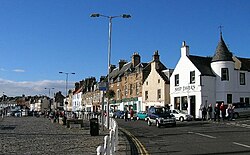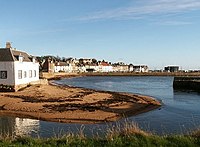Anstruther
| Anstruther | |
| Fife | |
|---|---|
 Anstruther seafront | |
| Location | |
| Grid reference: | NO564035 |
| Location: | 56°13’24"N, 2°42’10"W |
| Data | |
| Population: | 3,600 |
| Post town: | Anstruther |
| Postcode: | KY10 |
| Dialling code: | 01333 |
| Local Government | |
| Council: | Fife |
| Parliamentary constituency: |
North East Fife |
Anstruther is a small town in Fife, nine miles south-southeast of St Andrews. The two halves of Anstruther (the parishes of Anstruther Easter and Wester) are divided by a stream called Dreel Burn. With a population of 3,500, it is the largest community on the Firth of Forth's north-shore coastline known as East Neuk. The village of Cellardyke forms an easterly extension of Anstruther.
The village
Anstruther was originally founded as a fishing village (and in homage to it the Scottish Fisheries Museum is here). Its main industry today is tourism, although other small scale manufacturing and service industries continue.
Pleasure craft now moor in the harbour, and a golf course is laid out near the town. Anstruther Pleasure Cruises operate sightseeing/wildlife cruises from the harbour to the Isle of May, the United Kingdom's best puffin location, from April to October. An abundance of other interesting wildlife, including seal colonies, also inhabit the island.
The Waid Academy, the local state comprehensive school, is a focus of the community and through its secondary role as a community centre, offers a wide range of activities, sports, and entertainment. A sports hall, gym and swimming are all open here and open to public use.

The town has a fish and chip shop, Anstruther Fish Bar, which won Fish and Chip shop of the year in 2001-2002 and was awarded the same prize once again by the Sea Fish Organisation in 2009.
Parish kirks
The town is split across three parishes: Anstruther Easter, Wester and Kilrenny.
At the centre of Anstruther is Anstruther Easter parish church, standing on a small hill prominently looking over the town. This structure incorporates a tower/spire feature rare to Britain as a whole, but commonly met in this part of Fife. The graveyard slopes toward the sea surrounded by a coped wall. It surrounds the church to the north, south and east. The churchyard wall and rounded archway to the south date to 1631.
Anstruther Wester parish church sits in the very west of its parish adjacent to the Dreel Burn. The graveyard is bounded by the stream and a beach. In 1243, a church on this site was dedicated to St Nicholas. The present structure consists of a sixteenth-century tower and steeple and a mid-nineteenth-century main cell, which probably incorporates fabric from the mediæval church. The graveyard surrounds the church to the north, south and east. It contains a number of 17th century memorials. There are earthworks in the churchyard which mark the outline of the old church building.
The east of the town falls within the parish of Kilrenny, whose church is situate in that village.
Sights of the village
Dr Thomas Chalmers, the theologian who co-founded the Free Church of Scotland in 1843, was born here and his house is preserved.
Anstruther is a tourist destination and has a number of guest houses, hotels and self-catering options available.
Anstruther is close to the Caves of Caiplie situated on the coastal path to Crail.
Anstruther War Memorial is located in the cemetery, somewhat further inland. It is of an unusual war memorial form, being totally flat to the ground, in the centre of a landscaped roundel, broadly adopting the shape of a Celtic cross.
Somewhat out from the town center, on the coastal road to the west, stands the Dreel Tavern (taking its name from the adjacent burn). This fine building dates from the 17th century.
Secret bunker
After the end of the Cold War, one of Anstruther's best kept secrets has become a major tourist attraction. A secret nuclear bunker, built in 1951 and operational until 1993, is located on the B940 near the village. During its operational life, it looked like an ordinary domestic dwelling, but has been renovated and is now open to the public as a museum.[1]
The bunker was a subsidiary Regional Seat of Government in time of possible nuclear emergency and would have been occupied by the UK Armed Forces, UKWMO, Royal Observer Corps, and other Civil Service personnel.
History
Anstruther was the home of the Anstruther family. In December 1583, King James VI gave the town the status of a Royal Burgh and trading rights, recognizing the importance of the port, called the draucht of Anstruther. The bounds of the new Burgh were the "Silver Dyke" on the east, the low water line on the south, the Anstruther burn to the west, and the Kylrynnie march road.[2]
Outside links
| ("Wikimedia Commons" has material about Anstruther) |
References
- ↑ Secret Bunker
- ↑ Donaldson, Gordon, ed., Register of the Privy Seal of Scotland, vol.8 (1982), p.272-3
